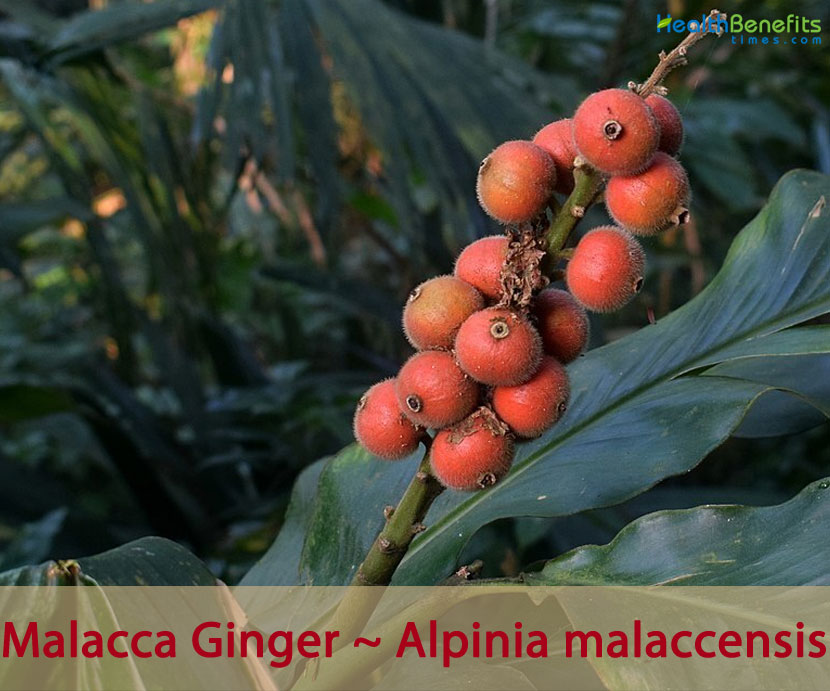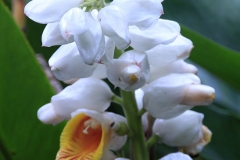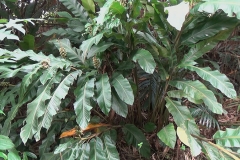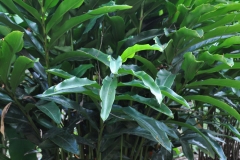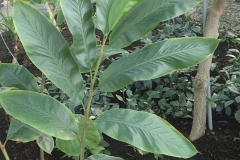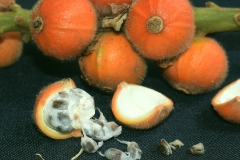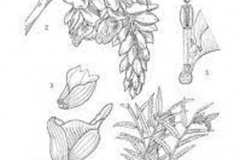| Malacca Ginger Quick Facts | |
|---|---|
| Name: | Malacca Ginger |
| Scientific Name: | Alpinia malaccensis |
| Origin | Northeast India to Indochina, Assam, Myanmar, Thailand, Peninsular Malaysia to China |
| Colors | Initially green turning to orange when ripe |
| Shapes | Capsule that is almost spherical about 2 cm in diam., with slight depressions at each end. They are covered with fine hairs |
| Health benefits | Support for sores, wounds, rheumatism, arthritis, intestinal disorders, scabies, stomachache, bronchitis, cough, healthy gums and teeth |
| Name | Malacca Ginger |
|---|---|
| Scientific Name | Alpinia malaccensis |
| Native | Northeast India to Indochina, Assam, Myanmar, Thailand, Peninsular Malaysia to China—Xizang and Yunnan. It is cultivated in India, Java and Southern Java |
| Common Names | Malacca Ginger, Malacca Galangal, Rieng Malacca, Ornamental Ginger |
| Name in Other Languages | Assamese: Kaupat Bengali: Deotara, Kulañjana (কুলঞ্জন) Chinese : Mao Ban Shan Jiang (毛瓣山姜) English: Malacca Ginger, Malacca Galangal, Rieng Malacca, Ornamental Ginger German : Malakka-Galgant Indonesia: Langkuas Malaka, Laja Gowah, Polang, Seruleu Gayo Puar, Lengkuas melaka Laos : Mak Kha Madhya Pradesh: Jangali Adrak Malayalam: Kāṭṭaratta (കാട്ടരത്ത) Malaysia : Bangle, Puar Meghalaya: Gong Mishing: Lisin Philippines : Simionan, Punan, Barapat, Kalaeug, Sigiapag, Tagusahis, Tam- Tamo, Birao-Birao, Bagumbung, Tagbak-Babae, Tagbak-Lalaki, Tukang-Maya Sudanese: Laja goah Thailand : Kha Pa (ข่าป่า ) Vietnamese : Riềng Malacca |
| Plant Growth Habit | Robust, perennial, rhizomatous herbaceous plant |
| Growing Climates | Secondary vegetation, bamboo and teak forest, brushwood and ravines, primary forest, shaded rocky outcrops and open areas near streams or rivers |
| Soil | Soils rich in organic matter from near sea level |
| Plant Size | 1.8-3 m or more in height |
| Stem | Plant produces leafy stems 2 – 4 meters tall from stout rhizomes just below the soil surface, growing close together in large clumps |
| Leaf | Plant produces leafy stems 2 – 4 meters tall from stout rhizomes just below the soil surface, growing close together in large clumps |
| Flowering season | April-May |
| Flower | Flowers are borne in erect racemes, up to 35 cm; axis stout, densely yellow velvet-hairy; bracteoles white, broadly elliptic, 3.5–4 cm. Flower-stalk is about 7 mm, densely yellow velvet-hairy |
| Fruit Shape & Size | Capsule that is almost spherical about 2 cm in diam., with slight depressions at each end. They are covered with fine hairs |
| Fruit Color | Initially green turning to orange when ripe |
| Plant Parts Used | Leaves, fruits, seeds and rhizome |
| Propagation | By seeds, dividing rhizomes, tubers, corms or bulbs (including offsets) |
Plant Description
Malacca Ginger is a robust, perennial, rhizomatous herbaceous plant that normally grows about 1.8-3 m or more in height. The plant is found growing in secondary vegetation, bamboo and teak forest, brushwood and ravines, primary forest, shaded rocky outcrops and open areas near streams or rivers. The plant prefers soils rich in organic matter from near sea level. The plant produces leafy stems 2 – 4 meters tall from stout rhizomes just below the soil surface, growing close together in large clumps. Ligule is 2-cleft, up to 1 cm and slightly tomentosa. They have a self-supporting growth form.
Leaves
The plant has large glossy green leaves arranged in 2 rows on the upper half of the stem. Leaves are oblong-lance or lance shaped, up to 60-90 cm long and 10-15 cm wide and abaxially pubescent; below velvet-hairy, base pointed and tip tapering. Petiole is 2 cm and is grooved.
Flower
The inflorescences are the showiest parts of the plant. They are held erect at the tip of the stem, bearing among the largest of the Alpinia flowers. Flowers are borne in erect racemes, up to 35 cm; axis stout, densely yellow velvet-hairy; bracteoles white, broadly elliptic, 3.5–4 cm. Flower-stalk is about 7 mm, densely yellow velvet-hairy. Calyx is bell-shaped, about 1.5 cm, densely silky. Flowers are white, silky; tube about 1 cm; lobes oblong-lanceshaped, 2.5–3 cm. Lateral staminodes are absent. Lip is yellow with red stripes, ovate, about 3.5 cm, tip notched. Stamen is about 2.4 cm long. Ovary is hairy.
The flowers are very attractive; especially the bright yellow lip mottled with red at the base, with red lines extending to the edge of the lip. Fully open flowers emit a slightly foul smell similar to rotten meat. Flowering normally takes place in between April till May.
Fruits
Fertile flowers are followed by capsule that is almost spherical about 2 cm in diam., with slight depressions at each end. They are covered with fine hairs and turn orange when ripe. If crushed, the fruits emit a smell like the leaves of Piper sarmentosum, a culinary spice and salad, known in Malaysia as ‘daun kadok’.
Traditional uses and benefits of Malacca Ginger
- Fruit is also utilized like the rhizomes medicinally.
- Rhizomes are crushed and applied to sores, wounds and boils.
- Ripe and unripe fruits are infused with salt and used as an emetic to control vomiting.
- Fragrant fruits are pounded and used for washing clothes and hairs by Amboinese girls as it leaves a pleasant scent.
- Oils of A. conchigera and A. malaccensis have been reported to be used in folk medicine in the treatment of rheumatism and arthritis.
- Rhizomes are used in the treatment of sores by the Mishing tribe in Assam, India, and in the Hoshangabad district in Madhya Pradesh, India.
- Decoction of the fruit or crushed seeds is applied on gastralgia with tympanites, and it is used for bathing feverish people in Philippines.
- In Sumedang and Subang, West Java, the leaf is used in children as an anti-vomiting, and rhizome oil used as massage oil.
- Juice from boiled rhizomes is used to treat intestinal disorders and crushed rhizomes used topical for scabies in Vietnam.
- Juice extracted from the leaves of the plant is used for the treatment of stomachache.
- An extract made with the fruit of the plant by boiling in water for having hot bath once a day for three days to treat fever.
- Fresh juice extracted from the rhizomes of the plant is taken twice a day (5 ml amount each time) for three days to treat indigestion.
- Pea sized pills made with the leaves of the plant are taken twice a day (2 pills each time) for two weeks to treat abdominal pain.
- Paste prepared from the rhizomes of the plant is applied to cure wounds and sores.
- Fresh juice extracted from the rhizomes of the plant is taken thrice a day (three tea spoons each time) for three days to treat respiratory problems like bronchitis.
- Fresh juice extracted from the leaves of the plant is used to treat cough.
- Flower buds juice in Luke warm water is used as a mouthwash for healthy gums and teeth.
- Rhizome decoction is used to wash blisters on skin.
- Fruits are prescribed as an emetic.
- Tuber paste of A. malaccensis is applied as curative on sores.
- An infusion of the ripe and unripe fruits, with a little salt, is taken as an emetic.
- Decoction is used for bathing feverish people.
- The rhizome is used as a traditional medicine to cure nausea, vomiting and certain wounds.
Culinary Uses
- In Indonesia and Laos the fruits are eaten.
- In Laos, both the fruits and the root of this herb can be used as food.
- Fruits are mainly collected and sold to Chinese traders; the villagers in Ban Kachet located in a mountainous area, 750 m altitude, in the north- western part of Luang Prabang province, themselves do not use the fruit.
- Root is for subsistence use as a spice and sold, bringing 50 kip/kg.
- The plant shoots are a local food item.
- Rhizome is occasionally used as a spice and is eaten as a vegetable in North eastern India.
- Rhizomes were chewed in the Moluccas, together with betel nut (Areca catechu) to make the voice strong and clear.
- Rhizome is cooked as vegetable by the Garo tribe in Meghalaya, India.
- The rhizome is occasionally used as a spice.
- The rhizome is eaten as a vegetable in India.
Other facts
- The plant is cultivated as an ornamental house plant.
- The aromatic oil, obtained from the leaves or rhizomes, is known by the trade name essence d’Amali or essence of Amali and is commonly used in perfumery.
- It is used also as a seasoning ingredient in processed meat.
References:
https://gd.eppo.int/taxon/AIIMA
http://www.theplantlist.org/tpl1.1/record/kew-218892
https://indiabiodiversity.org/species/show/264117
https://www.flowersofindia.net/catalog/slides/Malacca%20Ginger.html


